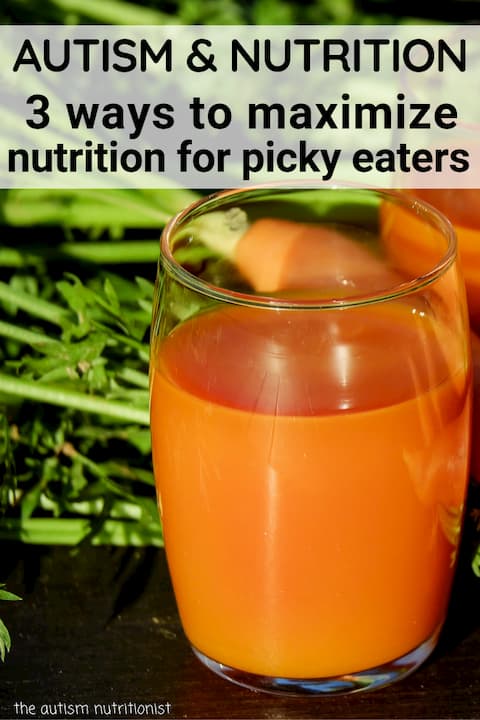
Autism parents worry that their picky eaters aren’t consuming the right nutrients. They see their child eating a limited number of foods, restricting entire food groups, refusing supplements, and eating only certain textures. Is it really possible such limited diet provides all of the vitamins, minerals, and nutrients a child needs to thrive and grow?
This is what an autism mom said to me last week: “My child won’t eat veggies at all, and fruit rarely. And he tends to eat one item three meals a day for months at a time. How is this impacting his health/vitamins/etc?”
Another mom who swaps her son’s favorite foods for healthier options that match the preferred texture asked for tricks to add nutritional content to foods.
Their concern is valid. Children on the spectrum tend to have lower vitamin and mineral levels compared to their neurotypical peers. Some research suggests that low nutrient levels can impact autism symptoms.
Parents get frustrated when doctors suggest they just feed their kid more vegetables. That’s not how autism picky eating works and parents know that! While I wholeheartedly recommend working to expand your child’s diet so he can eventually eat more foods (see some of my favorite ways here, here, and here), there are some ways to help your picky one eat a more nutritious diet in the meantime.
Try these tips to maximize nutrition for your autistic picky eater
How to Add More Fiber
Fiber intake is low in most autism kids’ diets. And constipation is a struggle for a lot of autistic kids. Is it some kind of belly issue or the result of a diet heavy in carbs and processed foods, but low in fiber? It’s a chicken or the egg situation, but the good news is that fiber is easy to add into many purees and baked goods.
-
Add pureed veggies or fruits to baked goods
-
Add ground flaxseed to smoothies, baked goods, and hot cereal
-
Swap whole wheat flour for up tp ½ of the flour in baked goods
-
Offer chia seeds in smoothies, yogurt, and hot cereal
-
Offer veggies with a favorite dip or dressing
-
Choose whole grain when possible
How to Add More Veggies
If you’re parent to a texture-averse picky eater who is partial to white foods, first, you’re not alone. Second, you’ve probably noticed vegetable intake is next to none.
-
Add cauliflower or zucchini to smoothies
-
Puree red peppers or carrots to a red tomato sauce
-
Make avocado chocolate pudding
-
Add veggie purees to baked goods like pancakes
-
Mix pumpkin puree and lots of cinnamon with oatmeal
-
Make pureed veggie soups
-
Offer veggies alongside a small portion of a favorite food at snack time
How to Add More Vitamin D
Try vitamin D drops. They’re easy to add to almost anything. Alison, a mom I’m working with who has a 4-year-old boy on the spectrum, adds vitamin D drops to peanut butter and grilled cheese sandwiches. Her son, Parker, likes to cook so he actually helps her makes the sandwiches and likes to add the drops.
Recap
Autistic children tend to have lower nutrient levels than kids without autism. Because many kids with autism struggle with taking nutritional supplements, parents try to add nutrition to the foods they currently eat. Fiber, vegetables, and vitamin D are easy nutrients and foods to begin incorporating in your autism child’s meal plan.
Homework
Select one tip from above and give it a try this week. If your child is very sensitive to changes in his or her food, start very slowly – just an addition the size of a grain of rice at first!
AND
My autism nutrition program is perfectly designed for picky kids who have trouble trying new foods. Sign up for a FREE Introductory call to get the support you need to expand your child’s diet.



0 Comments